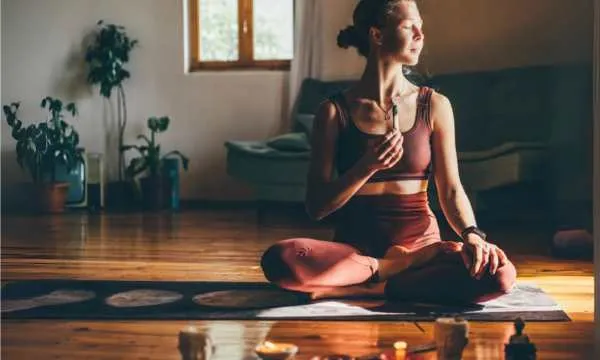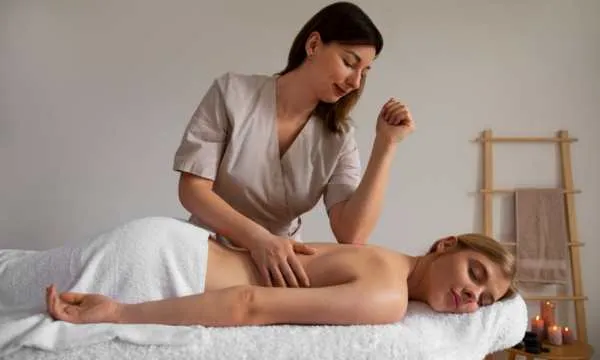Discover essential stretchings to protect your body, enhance mobility, and ensure a long, successful, pain free career.
Ad
As a massage professional, your body is your most valuable tool, subjected daily to hours of repetitive effort and demanding postures.
Fortunately, taking short breaks for intentional movements in your routine can help prevent stiffness, strain, and tension buildup.
Ad
These aren’t complex routines, but rather simple, targeted movements for the areas of your body that need the most attention in your daily work.
By adopting this practice, you invest directly in your professional longevity and the quality of your therapeutic touch.
Ad
In this practical guide, you’ll discover how to care for your muscles and joints, ensuring well being for yourself and for the people you care for.

Neck Movements to Prevent Cervical Stiffness
Hours of forward head posture can tighten the suboccipitals, upper trapezius, and levator scapulae. Gentle, regular neck stretchings nourish tissues and ease stiffness without aggressive pulling. Move slowly, breathe calmly, and stop if you feel sharp or unusual discomfort.
-
Chin nods: Sit tall, gently nod as if saying yes, lengthening the back of the neck, do 6 to 8 slow reps.
-
Neck rotations: Turn the head right and left within a comfortable range, do 5 slow reps each side.
-
Lateral flexion: Tilt ear toward shoulder, keep opposite shoulder relaxed, hold 10 to 20 seconds per side.
-
Seated upper back reset: Interlace fingers behind head, lift chest softly, and breathe into the ribs for 3 breaths.
Pair each neck movement with a slow exhale to help the shoulders soften and reduce bracing.
Light Shoulders and Arms to Strengthen Muscles and Reduce Strain
Shoulders and arms carry repeated loads during sessions. To stay comfortable, combine opening movements with gentle strengthening and short shoulder stretchings. This approach helps you maintain a neutral shoulder position, protect the rotator cuff, and reduce fatigue during longer treatments.
-
Doorway stretch: Stand in a doorway with elbows at 90 degrees, forearms on the frame, lean forward until you feel a chest stretch, hold 15 seconds.
-
Clock stretch: Stand beside a wall about 12 inches away, raise the right arm to the 12 o’clock position, lean toward the wall until you feel a side stretch, hold 5 to 10 seconds, then shift the hand to 1 o’clock and repeat through 6 o’clock, switch sides.
-
Scapular slides: Stand tall, draw shoulder blades down and together without arching the back, 8 controlled reps.
-
Band external rotation: With a light band at elbow height, keep elbows tucked and rotate forearms outward, 10 gentle reps.
Keep movements pain free and emphasize smooth breathing. Over time, small, consistent shoulder stretchings can restore comfortable range and build endurance without overloading sensitive tissues.
Gold Tip: Place a light resistance band near your treatment table to encourage quick, reinforcing sets between clients.
Free Your Hands and Wrists: Stretchings to Relieve Tension
Hands and wrists work tirelessly with sustained pressure, thumb glides, and precise mobilizations. Support them with intentional decompression and balanced strength so you can continue to provide high quality care without nagging soreness. These hand stretchings are short and effective.
-
Wrist and finger stretch: Extend the right arm with palm up with the left hand, gently pull back on fingers to feel a forearm stretch, hold 15 to 30 seconds and switch sides.
-
Forearm flexor stretch: Palm up, softly extend the wrist and pull fingers back without forcing and hold 15 to 30 seconds per side.
-
Forearm extensor stretch: Palm down, gently flex the wrist by guiding the back of the hand toward you and hold 15 to 30 seconds per side.
For comfort during sessions, vary techniques, use forearms or tools when appropriate, and adjust table height to reduce excessive wrist extension. Short, frequent stretchings prevent accumulation of tension and keep grip strength reliable.
Before the first client, perform 1 to 2 easy sets of wrist circles and finger flicks to warm tissues without fatigue.

Hand-and-wrist-stretches-(Source-Google)
Healthy Spine: Gentle Exercises to Maintain Posture
Posture is not perfectly still it is a dynamic balance. Mixing light strength with mobility helps your thoracic spine stay open and your lower back supported. Include simple spine stretchings and keep a smooth breath rhythm for the best results.
-
Seated row exercise: Fix a band at shoulder level, sit upright, pull elbows back while gently squeezing shoulder blades, then return with control, do 8 to 10 reps.
-
Thoracic extension: Sit tall, place hands behind head, lift the breastbone slightly, keep ribs relaxed, and breathe for 3 slow cycles.
-
Cat camel: On hands and knees, alternate rounding and lengthening the spine with steady breathing, do 6 to 8 gentle waves.
These moves complement hands on work by strengthening posterior support and countering prolonged forward leaning. Over days and weeks, you may notice easier standing alignment and less end of day tightness thanks to consistent stretchings.
Active Legs: Stretchings for Endurance During Long Workdays
Your legs stabilize every reach and transfer. Keeping calves, hamstrings, and hips mobile can make long shifts more comfortable and reduce end of day heaviness. Balance gentle mobility with light activation and leg stretchings to support circulation.
-
Calf wall stretch: Stand facing a wall, back heel down, lean forward until a calf stretch appears and hold 20 to 30 seconds per side.
-
Hip flexor lunge: Step one foot forward, drop the back knee gently, tuck the pelvis slightly, and feel the front of the hip open and hold 20 seconds per side.
-
Hamstring chair hinge: Place heel on a low surface, hinge at the hips with a long spine until you feel the back of the thigh and hold 15 to 20 seconds per side.
During short breaks, walk one quiet lap around the room and perform 10 relaxed ankle pumps to refresh circulation.
How and When to Do Stretches at Work
Consistency is easier when it feels natural. The 2021 research on massage professionals suggests that supportive schedules and environments help practitioners perform self-care more regularly. Build micro sessions of workday stretchings into natural pauses rather than saving everything for later.
-
Before first client: 3 minutes of neck mobility and wrist warm up.
-
Between sessions: 60 to 90 seconds of doorway stretch or seated row, plus 5 calm breaths.
-
Midday reset: One gentle walk, ankle pumps, and a brief calf stretch.
-
End of day: Slow forearm stretchings and thoracic extension to unwind.
-
General rule: Move within comfort, breathe slowly, and avoid forcing range.
Small, consistent actions and simple stretchings protect the body that cares for others.
Conclusion
A sustainable massage career thrives on caring for your own body first. By blending five essential stretchings with a few strengthening moves and brief movement breaks, you can reduce stiffness, manage workload demands, and feel more present with each client.
Start small, anchor your routine to natural pauses in the day, and refine as you learn what feels best. Your future self and every client you support will benefit from your steady commitment to self-care and consistent stretchings.


